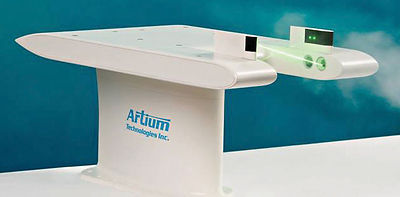
PDI Flight Probes
Droplet size and velocity measurements
Advantages of the PDI Flight Probes over Legacy Probes

Characterization of icing clouds and wind tunnel simulations require modern instruments for measuring droplet size distributions, droplet velocities, and liquid water content in realistic icing cloud and simulated icing cloud environments. Currently, instrumentation developed in the 1970’s by Particle Measuring Systems (PMS) have been widely used for this purpose. Liquid water content (LWC) measurements are generally acquired using hot wire devices based on the early Johnson-Williams approach (~1955). Although these instruments can provide accurate measurements of drop size distributions and LWC, they are also known to be limited in terms of measurement accuracy and reliability when subjected to challenging conditions. The key limitation of the PMS FSSP instrument is due to coincidence errors when measuring cloud droplet number densities greater than ~300/cc.
Furthermore, in helicopter applications the uncertainty in the droplet incident angles of trajectory can produce unacceptable measurement uncertainty. The hotwire devices are challenged by low flow speeds and small droplets. There is also a concern that when measuring SLD conditions, the large droplets may shatter on the hotwire devices producing measurement uncertainty. The phase Doppler interferometry (PDI) method has been demonstrated to be capable of handling a very wide range of droplet size distributions and has the added advantage of measuring the droplet size and velocity simultaneously. As such, not only the MVD but the liquid water content and droplet number densities can be measured with this single instrument. The PDI method is capable of measuring droplet sizes that are as small as 0.5 µm in diameter to droplets as large as 5000 µm in diameter or larger, provided that the droplets remain quasi-spherical. Artium has integrated the phase Doppler method into a single compact instrument that can be carried on aircraft including helicopters. riminate ice particles and droplets

To cover the full size range of 0.5 to 1000 µm, two instruments with overlapping measurement ranges are incorporated into one single package. Measured results are combined automatically using fundamental principles to produce an unprecedented dynamic droplet measurement range. Legacy instruments used for cloud characterization include the FSSP and the OAP developed by PMS. Besides being an old technology, these methods have several sources of measurement uncertainty including:
-
Oscillations in the light scattering intensity as a function of particle size
-
High particle concentrations
-
Coincidence errors due to multiple drops being present in the measurement volume at the same time
-
Change in calibration due to aircraft vibrations and/or contamination of the optics by particles
-
Insufficient de-icing of the probe causing flow blockage
-
Depth-of-field related errors (for OAP)
Such instrument deficiencies have been by addressed by the PDI Flight Probes including:
-
Limitations and measurement error due to high droplet number densities, coincidence
-
Flow blockage by ice accretion in the flow straightener and proximity to the main instrument body
-
Large droplet shattering on the flow straightener, measured as small droplets
-
Limited dynamic range for droplet sizing Measurement uncertainty due to flow speed and angle of trajectory
-
Depth of field errors with the OAP
-
Insufficient heating to de-ice the probes
-
Requirements for frequent calibrations and uncertainties due to calibration issues
-
Uncertainties due to optical contamination and misalignment
-
Uncertainties due to merging measurements from two disparate methods, FSSP and OAP
-
Uncertainties due to mixed phase conditions and the inability of the FSSP to discriminate ice particles and droplets